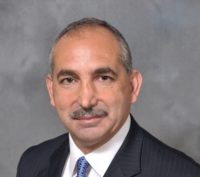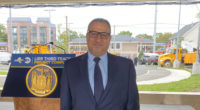The Gateway Development Commission recently selected James A. Morrison as chief technical officer. In the role, he will help lead its $16.1-billion Hudson Tunnel Project to build a new Northeast Corridor rail tunnel under the Hudson River between New Jersey and New York City and rehabilitate the existing 115-year-old North River Tunnel .
With more than 40 years of industry experience in tunnel, transit and other infrastructure projects, Morrison was most recently vice president and engineering chief at STV Inc. and also held leadership roles at ILF, COWI and Kiewit. He also has served on dispute resolution boards for major tunnel projects and is a past president of the Deep Foundations Institute and of American Society of Civil Engineers chapters.
This interview has been edited and condensed for clarity.
ENR: What made you want to join the Gateway Development Commission?
Morrison: This is the biggest project going on right now, one of the biggest that’s ever been done. And by biggest, I don’t just mean in dollar terms. This is the kind of project that has enough to keep you interested for a while. There’s a lot of pieces, a lot of history behind it. Putting together something like this is probably the biggest challenge you could have in North America right now. I find that fun.
What’s on your initial to-do list?
Besides just catching up to where the program is—there's a team here that's deep into developing procurement packages. What's on my list is making sure those packages being put together have the right information and the right format, and that we're approaching this project in a way that's both attractive to competition and can meet schedule and budget. And then setting up the team from a program level to oversee and manage this. That's one of the things we're doing right now, getting the right people in place to execute this work. The team that's here now is fantastic to work with. Everybody is enthusiastic and engaged, and we're off to a great start.
How many people are you bringing on?
It’s at several levels. At the program level under me, there will be three deputy positions—one focused on the tunneling and underground work; one on the systems side as tunnels are fitted for all the systems required to run a train; and the third to focus on the surface works interfacing with Amtrak and New Jersey Transit. Under that is a support team to manage project controls, focus on safety and develop details of our sustainability program. In addition, we will have a delivery partner, with that team now being selected and the organization of that group coming together.
You mentioned the challenge of working on a project of this size. What particular challenges are you anticipating?
There are technical challenges and organizational challenges. We have multiple contracts now coming out, with interfaces between each, so making sure we design and manage those contracts with smooth interfaces is a challenge, but it's an opportunity as well.
Related to the technical challenges, they include mining under the Hudson River, and going from hard rock into very soft ground. Coming into Manhattan under the bulkhead is one of the bigger technical challenges. As we get near Penn Station, the tunnels get shallow and there's a lot of activity and existing infrastructure to work through. So that's a real challenge. One of the contracts—one which we've issued a request for qualifications and will soon be seeking proposals—is to provide some ground stabilization in the river itself. Making sure we have enough improved ground so those tunnels can be mined seamlessly under the river is a big early piece of work that needs to be completed before any tunneling happens. Getting that out on the street requires specialty contractors and coordination with the U.S. Coast Guard and New York harbor safety agencies because it will be a marine operation.
With your experience working on tunnel projects, are there any that stick out as the most memorable?
All of them are unique in their own ways. Certainly the Rio Piedras system in Puerto Rico was an education to the industry on how to do design-build for complex underground tunneling. It was another project that was technically very complex where we were mining underground, and also one of the early uses of the geotechnical baseline report concept in the contracting. There were a lot of lessons learned in how to do that on a design-build project.
Another one just recently finished for the U.S. Army Corps of Engineers was Mud Mountain Dam in Washington state. This was a small project but one the team brought some innovation to. It was a sediment bypass tunnel under a dam that was eroding 2 in. of steel lining every five years. We came in with a concept as a design-build team to replace the steel lining with cut granite blocks, which should improve the performance manyfold. That was a very fun project. The chance to be innovative and bring new ideas is always fun.



![Jessica Becker ESA.[4] copy.jpg Jessica Becker ESA.[4] copy.jpg](https://www.enr.com/ext/resources/2022/Jessica-Becker-ESA.%5b4%5d-copy.jpg?height=200&t=1648001206&width=200)


Post a comment to this article
Report Abusive Comment